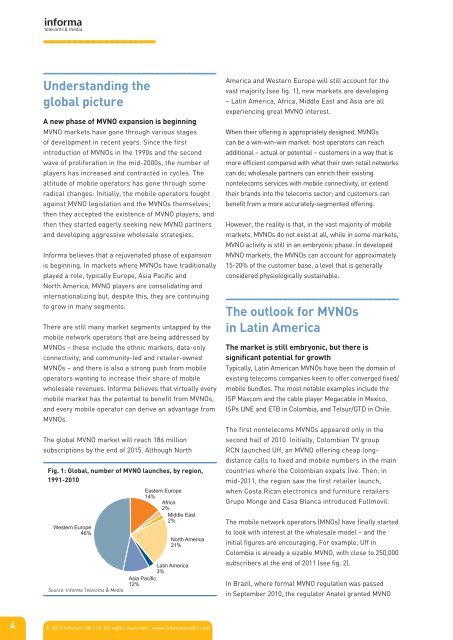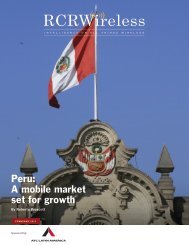You also want an ePaper? Increase the reach of your titles
YUMPU automatically turns print PDFs into web optimized ePapers that Google loves.
Understanding the<br />
global picture<br />
A new phase <strong>of</strong> <strong>MVNO</strong> expansion is beginning<br />
<strong>MVNO</strong> markets have gone through various stages<br />
<strong>of</strong> development in recent years. Since the first<br />
introduction <strong>of</strong> <strong><strong>MVNO</strong>s</strong> in the 1990s and the second<br />
wave <strong>of</strong> proliferation in the mid-2000s, the number <strong>of</strong><br />
players has increased and contracted in cycles. <strong>The</strong><br />
attitude <strong>of</strong> mobile operators has gone through some<br />
radical changes: Initially, the mobile operators fought<br />
against <strong>MVNO</strong> legislation and the <strong><strong>MVNO</strong>s</strong> themselves;<br />
then they accepted the existence <strong>of</strong> <strong>MVNO</strong> players; and<br />
then they started eagerly seeking new <strong>MVNO</strong> partners<br />
and developing aggressive wholesale strategies.<br />
Informa believes that a rejuvenated phase <strong>of</strong> expansion<br />
is beginning. In markets where <strong><strong>MVNO</strong>s</strong> have traditionally<br />
played a role, typically Europe, Asia Pacific and<br />
North America, <strong>MVNO</strong> players are consolidating and<br />
internationalizing but, despite this, they are continuing<br />
to grow in many segments.<br />
<strong>The</strong>re are still many market segments untapped by the<br />
mobile network operators that are being addressed by<br />
<strong><strong>MVNO</strong>s</strong> – these include the ethnic markets, data-only<br />
connectivity, and community-led and retailer-owned<br />
<strong><strong>MVNO</strong>s</strong> – and there is also a strong push from mobile<br />
operators wanting to increase their share <strong>of</strong> mobile<br />
wholesale revenues. Informa believes that virtually every<br />
mobile market has the potential to benefit from <strong><strong>MVNO</strong>s</strong>,<br />
and every mobile operator can derive an advantage from<br />
<strong><strong>MVNO</strong>s</strong>.<br />
<strong>The</strong> global <strong>MVNO</strong> market will reach 186 million<br />
subscriptions by the end <strong>of</strong> 2015. Although North<br />
Fig. 1: Global, number <strong>of</strong> <strong>MVNO</strong> launches, by region,<br />
1991-2010<br />
Western Europe<br />
46%<br />
Source: Informa Telecoms & Media<br />
Asia Pacific<br />
12%<br />
Eastern Europe<br />
14%<br />
Africa<br />
2%<br />
Middle East<br />
2%<br />
North America<br />
21%<br />
Latin America<br />
3%<br />
America and Western Europe will still account for the<br />
vast majority (see fig. 1), new markets are developing<br />
– Latin America, Africa, Middle East and Asia are all<br />
experiencing great <strong>MVNO</strong> interest.<br />
When their <strong>of</strong>fering is appropriately designed, <strong><strong>MVNO</strong>s</strong><br />
can be a win-win-win market: host operators can reach<br />
additional – actual or potential – customers in a way that is<br />
more efficient compared with what their own retail networks<br />
can do; wholesale partners can enrich their existing<br />
nontelecoms services with mobile connectivity, or extend<br />
their brands into the telecoms sector; and customers can<br />
benefit from a more accurately-segmented <strong>of</strong>fering.<br />
However, the reality is that, in the vast majority <strong>of</strong> mobile<br />
markets, <strong><strong>MVNO</strong>s</strong> do not exist at all, while in some markets,<br />
<strong>MVNO</strong> activity is still in an embryonic phase. In developed<br />
<strong>MVNO</strong> markets, the <strong><strong>MVNO</strong>s</strong> can account for approximately<br />
15-20% <strong>of</strong> the customer base, a level that is generally<br />
considered physiologically sustainable.<br />
<strong>The</strong> outlook for <strong><strong>MVNO</strong>s</strong><br />
in Latin America<br />
<strong>The</strong> market is still embryonic, but there is<br />
significant potential for growth<br />
Typically, Latin American <strong><strong>MVNO</strong>s</strong> have been the domain <strong>of</strong><br />
existing telecoms companies keen to <strong>of</strong>fer converged fixed/<br />
mobile bundles. <strong>The</strong> most notable examples include the<br />
ISP Maxcom and the cable player Megacable in Mexico,<br />
ISPs UNE and ETB in Colombia, and Telsur/GTD in Chile.<br />
<strong>The</strong> first nontelecoms <strong><strong>MVNO</strong>s</strong> appeared only in the<br />
second half <strong>of</strong> 2010. Initially, Colombian TV group<br />
RCN launched Uff, an <strong>MVNO</strong> <strong>of</strong>fering cheap longdistance<br />
calls to fixed and mobile numbers in the main<br />
countries where the Colombian expats live. <strong>The</strong>n, in<br />
mid-2011, the region saw the first retailer launch,<br />
when Costa Rican electronics and furniture retailers<br />
Grupo Monge and Casa Blanca introduced Fullmovil.<br />
<strong>The</strong> mobile network operators (MNOs) have finally started<br />
to look with interest at the wholesale model – and the<br />
initial figures are encouraging. For example, Uff in<br />
Colombia is already a sizable <strong>MVNO</strong>, with close to 250,000<br />
subscribers at the end <strong>of</strong> 2011 (see fig. 2).<br />
In Brazil, where formal <strong>MVNO</strong> regulation was passed<br />
in September 2010, the regulator Anatel granted <strong>MVNO</strong><br />
4<br />
© 2012 Informa UK Ltd. All rights reserved. www.informatandm.com
















